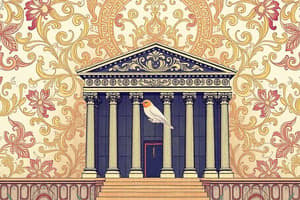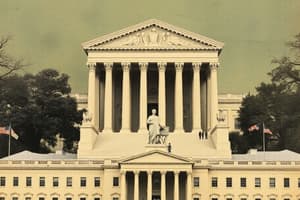Podcast
Questions and Answers
What is the primary difference between the state and U.S. court systems?
What is the primary difference between the state and U.S. court systems?
- State courts have original jurisdiction, while U.S. courts have appellate jurisdiction
- State courts handle state laws, while U.S. courts handle federal laws (correct)
- State courts have appellate jurisdiction, while U.S. courts have original jurisdiction
- State courts are responsible for international law, while U.S. courts are responsible for domestic law
What is the power of the federal judiciary?
What is the power of the federal judiciary?
- To enforce laws
- To interpret laws (correct)
- To appoint federal officials
- To make laws
What is the purpose of the checks and balance system on the power of the U.S. Supreme Court?
What is the purpose of the checks and balance system on the power of the U.S. Supreme Court?
- To eliminate the need for a legislative branch
- To prevent the Court from abusing its power (correct)
- To give the Court more power over the other branches of government
- To ensure the Court's decisions are final and unchallengeable
What is the difference between original and appellate jurisdiction?
What is the difference between original and appellate jurisdiction?
What is the purpose of special interest groups using litigation strategies to influence government policy?
What is the purpose of special interest groups using litigation strategies to influence government policy?
Which of the following is a characteristic of the federal court system?
Which of the following is a characteristic of the federal court system?
What is the primary role of the Supreme Court in the judicial decision-making process?
What is the primary role of the Supreme Court in the judicial decision-making process?
How do special interest groups use litigation strategies to influence government policy?
How do special interest groups use litigation strategies to influence government policy?
What is the primary constraint on the power of the Supreme Court?
What is the primary constraint on the power of the Supreme Court?
Which of the following is an example of appellate jurisdiction?
Which of the following is an example of appellate jurisdiction?
What is the primary function of the U.S. Supreme Court in the federal judiciary?
What is the primary function of the U.S. Supreme Court in the federal judiciary?
Which of the following is a check on the power of the Supreme Court?
Which of the following is a check on the power of the Supreme Court?
What is the main purpose of the judicial decision-making process?
What is the main purpose of the judicial decision-making process?
What is the primary way that special interest groups use litigation strategies to influence government policy?
What is the primary way that special interest groups use litigation strategies to influence government policy?
What is the term for the process by which the President selects and the Senate confirms Supreme Court justices?
What is the term for the process by which the President selects and the Senate confirms Supreme Court justices?
What is the primary role of the U.S. court system?
What is the primary role of the U.S. court system?
What is the main purpose of the Supreme Court's appellate jurisdiction?
What is the main purpose of the Supreme Court's appellate jurisdiction?
How do special interest groups use litigation strategies to influence government policy?
How do special interest groups use litigation strategies to influence government policy?
What is the primary check on the power of the Supreme Court?
What is the primary check on the power of the Supreme Court?
What is the primary role of the Supreme Court in the judicial decision-making process?
What is the primary role of the Supreme Court in the judicial decision-making process?
Flashcards are hidden until you start studying
Study Notes
Federal Judicial System
- The state and U.S. court systems differ in their jurisdictions, with state courts handling cases involving state laws and U.S. courts handling cases involving federal laws and the Constitution.
- The federal judiciary has the power to interpret laws, declare laws unconstitutional, and provide checks on the executive and legislative branches.
Structure of the Federal Court System
- The federal court system consists of the U.S. Supreme Court, 13 U.S. Courts of Appeals, and 94 U.S. District Courts.
Judicial Decision-Making Process
- The judicial decision-making process involves judges applying the law to the facts of a case, considering precedents, and making a ruling.
- The process also involves the appeals process, where decisions can be reviewed by higher courts.
Checks and Balances on the Supreme Court
- The power of the U.S. Supreme Court is limited by the checks and balances system, which allows Congress to impeach and remove judges, and the President to appoint new judges.
Original and Appellate Jurisdiction
- Original jurisdiction refers to the authority of a court to hear a case for the first time, whereas appellate jurisdiction refers to the authority to review a case on appeal.
Selection of Supreme Court Justices
- Supreme Court Justices are nominated by the President and confirmed by the Senate, with the goal of achieving a fair and impartial judiciary.
Litigation Strategies and Government Policy
- Special interest groups use litigation strategies to influence government policy by filing lawsuits, amicus briefs, and class-action suits to shape policy and advocate for their interests.
Federal Judicial System
- The state and U.S. court systems differ in their jurisdictions, with state courts handling cases involving state laws and U.S. courts handling cases involving federal laws and the Constitution.
- The federal judiciary has the power to interpret laws, declare laws unconstitutional, and provide checks on the executive and legislative branches.
Structure of the Federal Court System
- The federal court system consists of the U.S. Supreme Court, 13 U.S. Courts of Appeals, and 94 U.S. District Courts.
Judicial Decision-Making Process
- The judicial decision-making process involves judges applying the law to the facts of a case, considering precedents, and making a ruling.
- The process also involves the appeals process, where decisions can be reviewed by higher courts.
Checks and Balances on the Supreme Court
- The power of the U.S. Supreme Court is limited by the checks and balances system, which allows Congress to impeach and remove judges, and the President to appoint new judges.
Original and Appellate Jurisdiction
- Original jurisdiction refers to the authority of a court to hear a case for the first time, whereas appellate jurisdiction refers to the authority to review a case on appeal.
Selection of Supreme Court Justices
- Supreme Court Justices are nominated by the President and confirmed by the Senate, with the goal of achieving a fair and impartial judiciary.
Litigation Strategies and Government Policy
- Special interest groups use litigation strategies to influence government policy by filing lawsuits, amicus briefs, and class-action suits to shape policy and advocate for their interests.
Federal Judicial System
- The state and U.S. court systems differ in their jurisdictions, with state courts handling cases involving state laws and U.S. courts handling cases involving federal laws and the Constitution.
- The federal judiciary has the power to interpret laws, declare laws unconstitutional, and provide checks on the executive and legislative branches.
Structure of the Federal Court System
- The federal court system consists of the U.S. Supreme Court, 13 U.S. Courts of Appeals, and 94 U.S. District Courts.
Judicial Decision-Making Process
- The judicial decision-making process involves judges applying the law to the facts of a case, considering precedents, and making a ruling.
- The process also involves the appeals process, where decisions can be reviewed by higher courts.
Checks and Balances on the Supreme Court
- The power of the U.S. Supreme Court is limited by the checks and balances system, which allows Congress to impeach and remove judges, and the President to appoint new judges.
Original and Appellate Jurisdiction
- Original jurisdiction refers to the authority of a court to hear a case for the first time, whereas appellate jurisdiction refers to the authority to review a case on appeal.
Selection of Supreme Court Justices
- Supreme Court Justices are nominated by the President and confirmed by the Senate, with the goal of achieving a fair and impartial judiciary.
Litigation Strategies and Government Policy
- Special interest groups use litigation strategies to influence government policy by filing lawsuits, amicus briefs, and class-action suits to shape policy and advocate for their interests.
Federal Judicial System
- The state and U.S. court systems differ in their jurisdictions, with state courts handling cases involving state laws and U.S. courts handling cases involving federal laws and the Constitution.
- The federal judiciary has the power to interpret laws, declare laws unconstitutional, and provide checks on the executive and legislative branches.
Structure of the Federal Court System
- The federal court system consists of the U.S. Supreme Court, 13 U.S. Courts of Appeals, and 94 U.S. District Courts.
Judicial Decision-Making Process
- The judicial decision-making process involves judges applying the law to the facts of a case, considering precedents, and making a ruling.
- The process also involves the appeals process, where decisions can be reviewed by higher courts.
Checks and Balances on the Supreme Court
- The power of the U.S. Supreme Court is limited by the checks and balances system, which allows Congress to impeach and remove judges, and the President to appoint new judges.
Original and Appellate Jurisdiction
- Original jurisdiction refers to the authority of a court to hear a case for the first time, whereas appellate jurisdiction refers to the authority to review a case on appeal.
Selection of Supreme Court Justices
- Supreme Court Justices are nominated by the President and confirmed by the Senate, with the goal of achieving a fair and impartial judiciary.
Litigation Strategies and Government Policy
- Special interest groups use litigation strategies to influence government policy by filing lawsuits, amicus briefs, and class-action suits to shape policy and advocate for their interests.
Studying That Suits You
Use AI to generate personalized quizzes and flashcards to suit your learning preferences.





